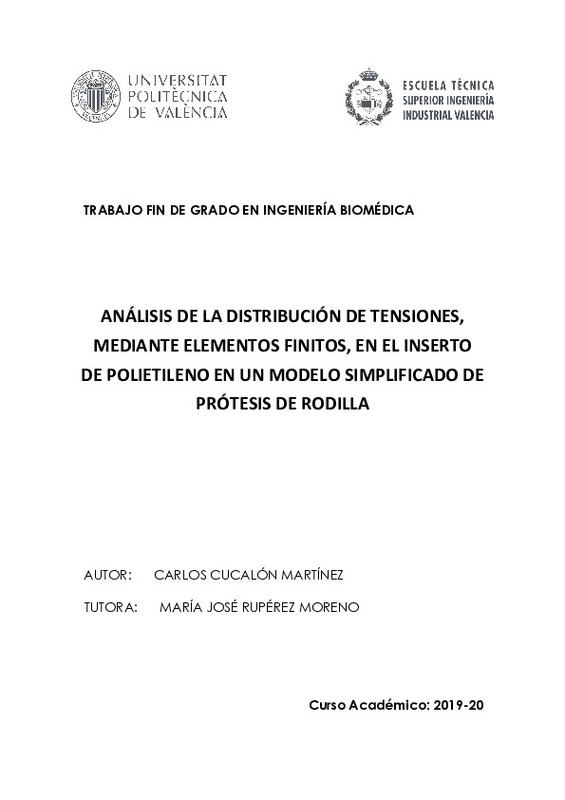|
Resumen:
|
[ES] El propósito del presente trabajo es obtener la relación entre el grosor del inserto de polietileno
de ultra alto peso molecular (UHMWPE) y la distribución de tensiones que se dan en el mismo.
Esto puede ayudar a ...[+]
[ES] El propósito del presente trabajo es obtener la relación entre el grosor del inserto de polietileno
de ultra alto peso molecular (UHMWPE) y la distribución de tensiones que se dan en el mismo.
Esto puede ayudar a la elección correcta del grosor del inserto de polietileno, a la hora de realizar
un implante, y reducir el número de fracasos que se dan en las prótesis de rodilla. Para ello
hemos trabajado con un programa de elementos finitos (ANSYS) donde hemos hecho uso de
tres modelos simplificados de prótesis de rodilla. Los grosores del inserto de polietileno
utilizados para el estudio han sido 4, 6, 8, 10, 12 y 14mm. Cabe recordar que por la normativa
(ISO), que el espesor mínimo permitido para un inserto de polietileno en prótesis de rodilla es
de 6mm.
Para el estudio de la distribución de tensiones se han analizado tensiones en los ejes X,
Y y Z, tensión de von Mises, tensiones principales S1, S2, S3 y tensiones tangenciales SXY, SXZ e
SYZ. Se ha obtenido que, de forma general, la tensión de von Mises aumentan al disminuir el
espesor por debajo de 6mm, al igual que lo hacen las tensiones tangenciales, por lo que hemos
confirmado con un estudio numérico la razón del espesor recomendado.
Un siguiente paso en la línea de este trabajo, y que completaría el estudio de la
respuesta del inserto de polietileno en prótesis de rodilla, sería llevar a cabo un ejercicio similar
modelando una geometría real de una prótesis de rodilla, variando el espesor del inserto de
polietileno. Del estudio realizado, se concluye, por las propiedades del UHMWPE, que un
espesor inferior al de la norma es capaz de soportar las tensiones generadas no produciendo
fallo por fluencia, aunque sí por desgaste. De todos modos, se debería determinar su
comportamiento a largo plazo mediante estudios tribológicos y estudios de fatiga, para
determinar, con mayor precisión, el espesor óptimo del inserto.
[-]
[EN] The purpose of the present paper is to determine the relationship between the thickness of the
ultra-high molecular weight polyethylene insert (UHMWPE) and the stress distribution within it.
This can lead to the ...[+]
[EN] The purpose of the present paper is to determine the relationship between the thickness of the
ultra-high molecular weight polyethylene insert (UHMWPE) and the stress distribution within it.
This can lead to the correct choice of the thickness of the polyethylene insert when performing
an implant and reduce the number of errors that occur in knee prostheses. For this purpose we
have worked with a finite element program (ANSYS) where we have used three simplified
models of knee prosthesis. The thicknesses of the polyethylene insert used for this study were
4, 6, 8, 10, 12 and 14 mm. According to the ISO regulations, the minimum thickness allowed for
a polyethylene insert in knee prostheses is 6mm.
In order to study the stress distribution, stresses in the X, Y and Z axes, von Mises
stresses, main stresses S1, S2, S3 and tangential stresses SXY, SXZ and SYZ have been analysed.
The results show that, in general, the von Mises stresses increase when the thickness decreases
below 6 mm, as do the tangential stresses. Therefore, we have confirmed the reason for the
recommended thickness with a numerical study.
A next step in the line of this work, and which would complete the study of the response
of the polyethylene insert in knee prostheses, would be to carry out a similar exercise by
modeling a real geometry of a knee prosthesis, varying the thickness of the polyethylene insert.
From the study carried out, it is concluded, due to the properties of UHMWPE, that a thickness
lower than the standard is capable of withstanding the stresses generated without producing
failure caused by yield, although it does produce wear. In any case, its long-term behavior should
be determined by means of tribological studies and fatigue studies, in order to determine, with
greater precision, the optimum thickness of the insert.
[-]
|







